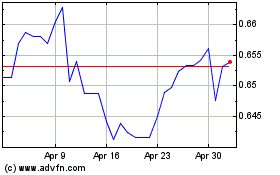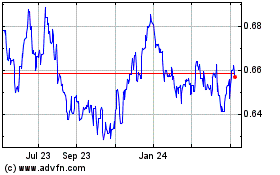U.S. Dollar Trades Higher Against Most Majors
August 07 2019 - 5:21AM
RTTF2
The U.S. dollar traded higher against its most major
counterparts in the European session on Wednesday, as fears over a
full-blown currency war receded and investors cheered dovish policy
action by three Asian central banks to support their economies from
a global slowdown.
China's central bank set its reference rate for the yuan below
the psychologically important 7-per-dollar level. Investors
welcomed indications of China stepping in to steady the yuan that
could prevent the trade war from turning into a currency war.
Speaking to CNBC, President Donald Trump's top economic adviser
Larry Kudlow said that the U.S-China trade talks are likely to
resume in September.
The U.S. is willing to negotiate, he said, adding that the
President and his team is planning for a Chinese visit in
September.
The central banks of New Zealand, India and Thailand surprised
markets by delivering interest rate cuts than had been
expected.
While NZ's central bank unexpectedly reduced its benchmark rate
to a record low, the Bank of Thailand and the Reserve Bank of India
also joined global easing to cope up with slowing economic
growth.
On the economic front, U.S. consumer credit for June is due at
3:00 pm ET.
The currency slipped against its major opponents in the Asian
session.
The greenback appreciated to a 2-day high of 0.9797 against the
franc from Tuesday's closing value of 0.9764. If the greenback
rises further, 0.99 is likely seen as its next resistance
level.
The greenback rose to 1.1179 against the euro, from a low of
1.1220 hit at 9:45 pm ET. On the upside, 1.10 is possibly seen as
the next resistance level for the greenback.
Data from Destatis showed that Germany's industrial production
declined more than expected in June.
Industrial production fell 1.5 percent on a monthly basis in
June, reversing a revised 0.1 percent rise in May. Output was
forecast to drop moderately by 0.5 percent.
The U.S. currency strengthened to a 2-day high of 1.2122 against
the pound from yesterday's closing quote of 1.2161. The currency is
likely to face resistance around the 1.20 level.
Figures from the Lloyds Bank subsidiary Halifax and IHS Markit
showed that UK house prices decreased for the second straight month
in July.
House prices fell unexpectedly by 0.2 percent month-on-month in
July, after falling 0.4 percent in June. This was the second
consecutive drop in prices. Economists had forecast a 0.3 percent
rise.
The greenback climbed to 1.3337 against the loonie, its highest
since June 19. The greenback is seen finding resistance around the
1.35 level.
The greenback held steady against the aussie amd the kiwi, after
having advanced to more than a 10-year high of 0.6677 and a
3-1/2-year high of 0.6377, respectively in the Asian session. The
greenback had ended Tuesday's trading at 0.6759 against the aussie
and 0.6524 versus the kiwi.
In contrast, the greenback declined to 105.71 against the
Japanese currency, compared to 106.46 hit late New York Tuesday.
The greenback is poised to find support around the 104.00
region.
Looking ahead, U.S. consumer credit for June and Canada Ivey PMI
for July are scheduled for release in the New York session.
AUD vs US Dollar (FX:AUDUSD)
Forex Chart
From Aug 2024 to Sep 2024

AUD vs US Dollar (FX:AUDUSD)
Forex Chart
From Sep 2023 to Sep 2024
